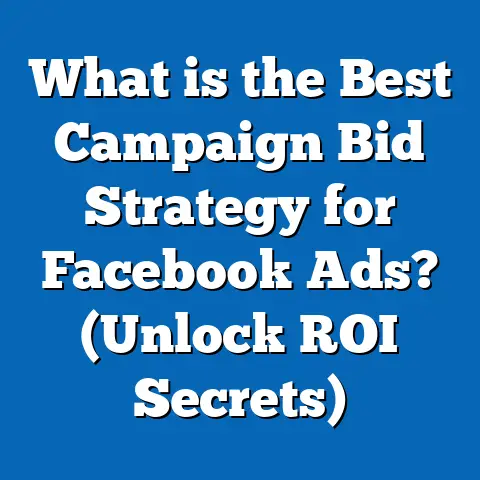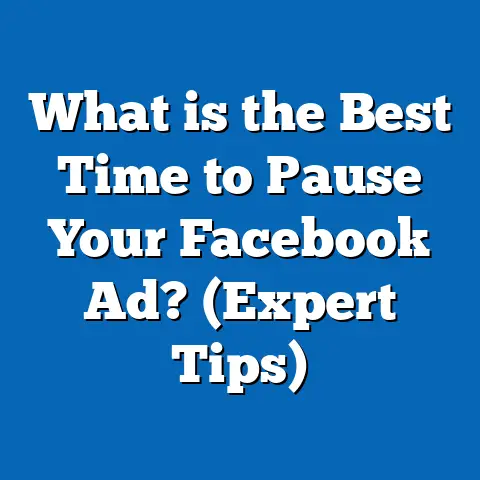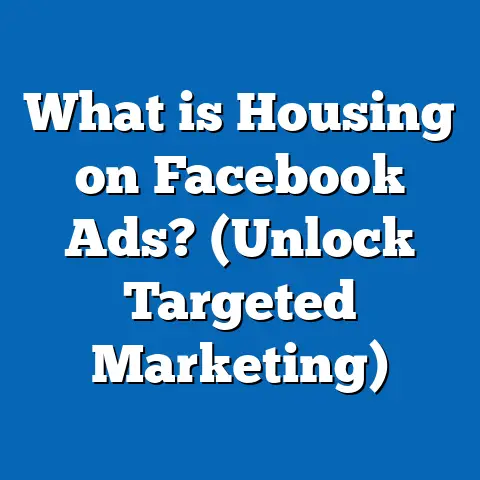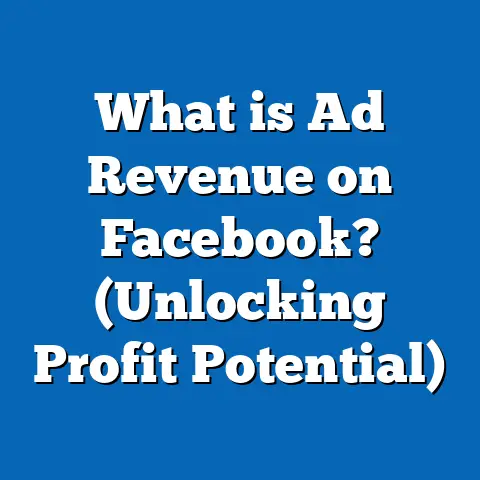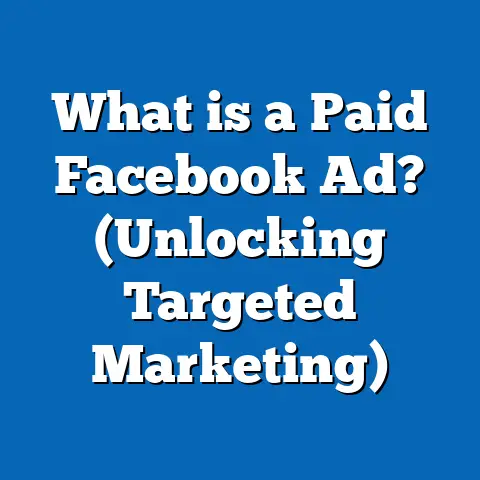What is the Facebook Ads Learning Phase? (Unlocking Campaign Success)
Introduction: The Power of Upgrades in Facebook Advertising
Facebook Ads have evolved significantly over the years, with continual upgrades aimed at improving advertiser control, targeting precision, and campaign outcomes. These upgrades include advanced algorithms, new bidding strategies, more granular audience segmentation, and improved reporting tools.
Among these changes, understanding Facebook’s Ads Learning Phase has become critical for marketers who want to maximize their ad performance and return on investment (ROI). This phase is one of the most important yet least understood aspects of Facebook advertising. It represents a period where Facebook’s delivery system experiments and learns how to best show your ads to the people most likely to take your desired action.
Ignoring or mismanaging the learning phase can lead to wasted ad spend, unstable campaign performance, and missed growth opportunities. This guide will explain everything you need to know about the learning phase—from basic concepts to advanced strategies—helping you unlock sustainable campaign success.
What is the Facebook Ads Learning Phase?
Definition and Purpose
The Facebook Ads Learning Phase is an initial period after launching or making significant edits to an ad set during which Facebook’s delivery system gathers data and optimizes your ads for performance. The learning phase helps Facebook’s algorithm understand which types of users are most likely to engage with your ads and convert based on your chosen objective.
This process involves testing different audience segments, placements, bidding strategies, and delivery optimizations. Facebook needs a minimum number of conversion events (approximately 50 per ad set) within a 7-day window to collect enough data for reliable optimization.
How the Learning Phase Works
When you launch a new ad set or make major changes such as:
- Changing targeting parameters
- Adjusting budget or bid strategy
- Updating creative assets
the learning phase starts (or restarts). During this time:
- Facebook’s machine learning models test various delivery options.
- The system explores different ways to allocate impressions.
- Performance metrics such as cost per result (CPR), click-through rate (CTR), and conversion volume may fluctuate.
- Once enough data is gathered, Facebook exits the learning phase and optimizes delivery more efficiently.
Why Understanding It Matters
Campaigns within the learning phase often experience inconsistent results and higher costs. Marketers who don’t account for this may misinterpret early performance as campaign failure and make premature changes that reset learning.
Recognizing the learning phase allows you to:
- Set proper expectations for early performance
- Avoid unnecessary edits during this critical period
- Structure campaigns to exit learning quickly
- Improve long-term campaign efficiency and ROI
The Science Behind the Learning Phase: Machine Learning in Action
How Facebook Uses Machine Learning
Facebook’s algorithm uses machine learning models trained on billions of data points from users’ behaviors. Its goal is to predict which users are most likely to take your desired action (purchase, lead form submission, app install, etc.).
During the learning phase:
- The algorithm tests different user segments within your target audience.
- Delivery is adjusted dynamically based on real-time feedback.
- The system identifies patterns such as time of day, device types, demographics, and interests that correlate with conversions.
This experimental phase is essential because without sufficient data, the algorithm cannot reliably predict who will convert, leading to suboptimal ad delivery.
Conversion Events: The Foundation of Learning
Optimization relies heavily on conversion events you choose for your campaign:
- Standard Events: Purchase, Add to Cart, Lead, Complete Registration
- Custom Events: Specific actions defined via pixel or SDK
Facebook requires roughly 50 conversion events per ad set within 7 days to build statistically reliable optimization models. If this threshold isn’t met, campaigns enter a “Learning Limited” phase where optimization potential decreases.
Data Insights: Quantifying the Learning Phase Impact
Performance Differences Between Learning Phase and Post Learning
Studies from Facebook and independent advertisers show clear performance gaps during versus after the learning phase:
| Metric | During Learning Phase | After Learning Phase |
|---|---|---|
| Cost Per Conversion (CPC) | Higher by 15-30% | Lower, more stable |
| Return on Ad Spend (ROAS) | Fluctuating, unpredictable | Consistent improvement |
| Conversion Volume | Lower | Higher due to better targeting |
| Frequency | Often higher due to inefficient delivery | Optimized for balanced exposure |
Industry Case Study: SaaS Lead Generation Campaign
A SaaS company running Facebook lead ads observed:
- Week 1 (Learning Phase): $45 CPL (Cost Per Lead)
- Week 3 (Post-Learning): $30 CPL
- Leads increased by 40% while costs decreased by 33%
- Conversion rates improved from 1.2% to 2.1%
This case demonstrates the critical importance of allowing campaigns to exit learning before judging performance.
Breaking Down the Learning Phase: Key Components
1. Conversion Event Volume Requirements
Facebook needs a minimum of about 50 optimized events per ad set in a rolling 7-day window.
- If you optimize for purchases but get only 5 purchases weekly, it will be difficult to exit learning.
- You might consider optimizing for higher-frequency events like “Add to Cart” initially.
2. Impact of Edits on Learning Status
Major edits retrigger learning:
| Edit Type | Effect on Learning Phase |
|---|---|
| Budget changes | Resets learning |
| Targeting tweaks | Resets learning |
| Creative updates | Resets learning |
| Bid strategy adjustments | Resets learning |
| Minor edits (e.g., text) | May not reset but can cause instability |
3. “Learning Limited” Status
If your campaign struggles to reach 50 conversions per week, it enters “Learning Limited” status:
- Indicates insufficient data for optimization
- Causes higher costs or lower volume
- Can be resolved by increasing budget or broadening audience
Strategies for Exiting the Learning Phase Faster
Budgeting for Success
Calculate your expected conversion cost and multiply by 50 to determine a minimum budget: Minimum Budget=Average Cost Per Conversion×50\text{Minimum Budget} = \text{Average Cost Per Conversion} \times 50
If your average cost per conversion is $10: 10×50=$500 minimum budget/week10 \times 50 = \$500 \text{ minimum budget/week}
This ensures enough data flows into the system.
Avoid Frequent Campaign Edits
Plan campaigns carefully before launch:
- Finalize targeting and creative assets.
- Limit changes during first week.
- Group necessary edits together.
Use Campaign Budget Optimization (CBO)
CBO automatically distributes budget across ad sets showing best results:
- Accelerates data collection.
- Helps balance spend based on performance.
Optimize for More Frequent Events Initially
Start optimizing for events with higher frequency such as “Add to Cart” or “Initiate Checkout” before switching to “Purchases.”
Practical Examples: Applying Learning Phase Knowledge Across Industries
E-commerce Example
An online fashion brand launched three ad sets optimized for purchases but struggled with low volume.
They switched optimization to “Add to Cart” for two weeks:
- Achieved 50+ events per ad set.
- Exited learning faster.
- After sufficient data was collected, switched back to “Purchase” optimization.
Result: Cost per purchase dropped by 25% within one month.
Lead Generation Example
A real estate company optimized lead ads for form completions but had a small audience.
They broadened targeting slightly and increased daily budget by 20%:
- Increased leads from 20/week to 60/week.
- Exited learning phase faster.
Deep Dive: Technical Aspects of Facebook’s Delivery Algorithm Post-Learning Phase
Predictive Modeling
Once out of learning phase, Facebook employs refined predictive models that consider:
- User behavior history
- Device type
- Time of day
- Past ad interaction patterns
These models continuously update using new data but are more stable than during learning phase.
Delivery Optimization Across Placements
Facebook dynamically shifts ad delivery among placements (Feeds, Stories, Audience Network) based on where conversions are more likely.
This placement-level optimization becomes more effective post-learning.
Comparison with Other Advertising Platforms’ Learning Periods
| Feature | Facebook Ads | Google Ads | TikTok Ads |
|---|---|---|---|
| Conversion events required | ~50 conversions per ad set | ~15 conversions per campaign | Varies; usually ~50 conversions |
| Reset triggers | Major edits (budget, targeting) | Bid or setting changes | Significant edits |
| Optimization focus | Audience & placement delivery | Keyword & auction bids | Audience & creative performance |
| Feedback transparency | Clear “Learning,” “Learning Limited” statuses | Limited | Basic notifications |
Each platform’s learning period reflects algorithm differences but shares core principles around data sufficiency.
Common Misconceptions About the Learning Phase Debunked
- “More budget always speeds up learning.”
Budget must align with realistic conversion volume potential; overspending doesn’t guarantee better results. - “Changing ads frequently boosts performance.”
Frequent edits reset learning, causing unstable costs and delivery. - “Learning phase ends within 24 hours.”
It usually lasts several days or longer depending on event volume and campaign edits. - “Small audiences learn faster.”
Smaller audiences may have fewer conversions, delaying learning completion.
Optimizing Creative and Targeting Within Learning Constraints
Creative Testing Outside Learning Phase
Use A/B testing tools such as Facebook Experiments or Test & Learn before launching main campaigns to refine creatives without impacting learning phase.
Layered Targeting Strategy
Start with broader audiences for rapid data collection then narrow down post-learning based on insights.
Measuring Success: KPIs Across Learning Phases
Before Exiting Learning Phase
Expect:
- Higher Cost per Result (CPR)
- Variable conversion rates
- Lower impression share efficiency
- Fluctuating CTRs
After Exiting Learning Phase
Look for:
- Stable or decreasing CPR
- Consistent conversion rates
- Higher impression share efficiency
- Optimized frequency rates
Use Facebook Ads Manager’s Delivery column status indicators (“Learning,” “Active,” “Learning Limited”) alongside key metrics.
Emerging Trends Affecting the Learning Phase in 2025
AI Enhancements in Optimization
Facebook continues enhancing AI models using advanced machine learning techniques like deep learning and reinforcement learning, promising faster and more accurate optimization post-learning.
Privacy Changes Impacting Data Availability
iOS privacy updates and restrictions on third-party cookies have reduced event tracking fidelity:
- Slows down data accumulation.
- May extend learning phases.
Marketers must adapt by using aggregated event measurement and first-party data strategies.
Automation Tools Integration
Facebook’s Automated Ads and Advantage+ campaigns aim at minimizing manual adjustments and reducing human errors that cause unnecessary resets in the learning phase.
Frequently Asked Questions about Facebook Ads Learning Phase
Q1: Can I run multiple ad sets simultaneously without affecting learning?
Yes, but each ad set learns independently. If budgets are too low per ad set, they may enter “Learning Limited.”
Q2: How do I know when the learning phase ends?
Facebook labels ad sets as “Learning” while in this phase. Once sufficient data is collected, status changes to active or “Learning Limited.”
Q3: What happens if I pause my campaign during the learning phase?
Pausing interrupts data flow; when resumed it may delay or restart learning depending on duration paused.
Summary: Unlocking Campaign Success Through Mastery of the Learning Phase
Understanding and managing the Facebook Ads Learning Phase is essential for any advertiser seeking consistent results and efficient use of budget. Key points include:
- The learning phase allows Facebook’s algorithm to collect data needed for effective optimization.
- Approximately 50 conversions per ad set over 7 days are required to exit this phase.
- Frequent changes reset the phase; avoid unnecessary edits early on.
- Proper budgeting aligned with conversion volume accelerates exit from learning.
- Use CBO and optimize for events with sufficient frequency.
- Post-learning phase campaigns perform more consistently with improved cost efficiency.
By respecting this critical process and applying best practices outlined here, marketers can reduce wasted spend, improve campaign stability, and maximize ROI.
If you want me to include additional case studies from specific industries or create step-by-step guides for campaign setup focused on avoiding prolonged learning phases, just let me know!

